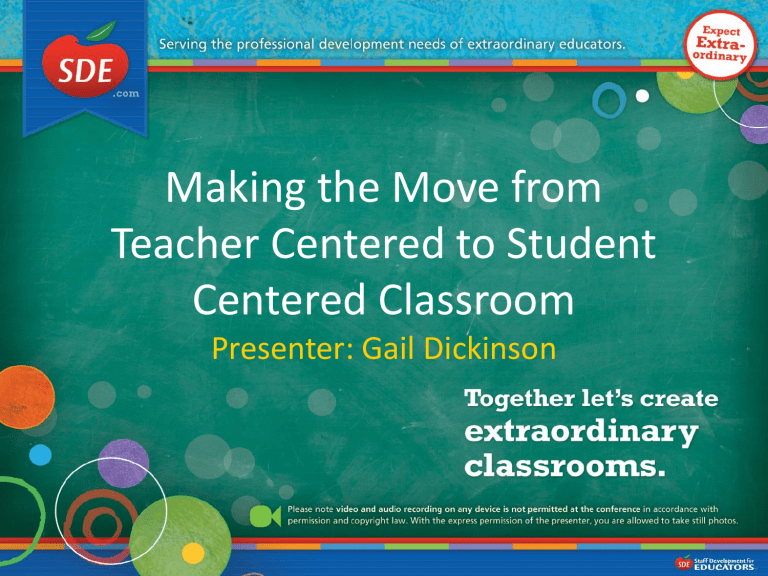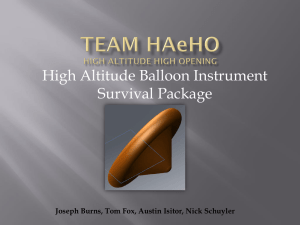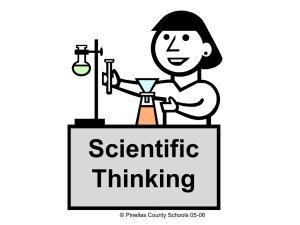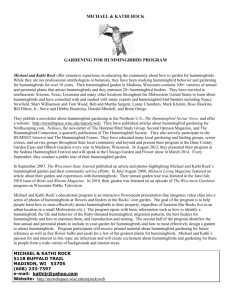Lesson Focus - Velma Jackson High

Making the Move from
Teacher Centered to Student
Centered Classroom
Presenter: Gail Dickinson
Session Notes
• For a copy of the notes go to the following website.
• GMSmavs.com/Teachers/Gail Dickinson/SDE
• Note: the videos will not work on the PowerPoint presentation.
Session Focus
Participants will
• explore the difference between teacher-centered and student-centered classrooms.
• learn ways to transform the typical teacher-centered classroom by encouraging discovery and exploratory learning that requires student engagement to solve problems.
• take on the role of students and will execute STEM performance based activities.
• be able to “flip” their classroom from teacher to student centered.
Why Change?
Today all students must be able to
• think critically
• communicate effectively
• collaborate with others
• analyze information
• deal with real-world problem solving
While meeting rigorous benchmarks, such as those contained in the common core state standards
What are student expectations?
• Video
Comparison
Teacher-Centered Student-Centered
Teacher is active
Instructor & decision maker
Bases teaching on standards
Students are passive
Teacher is facilitator & students are decision makers
Learning is based on prior knowledge & constructivism
Relies on textbooks & lectures Highlights real life examples
Comparison (cont.)
Teacher-Centered Student-Centered
Rote knowledge
Isolated teaching and learning
Learning takes place in classroom
Focus is on procedure
Little or no differentiation
Little knowledge of every student
Experiential Knowledge
Collaboration
Learning goes beyond the classroom
Focus is on thinking
Differentiated
Gets to know students
Examples of Student-Center Activities
• Repurpose
• Role play/Simulations
• Cooperative learning
• Inquiry
• Solve a problem
Get to Know Your Students
(DI)
• Paper Plate
• Wordle
• Concept Map
• Write a Fairy Tale/Song
• Bioglyph
Paper Plate-Student
Paper Plate-Teacher
Wordle www.wordle.net
Wordle
Concept Map using Inspiration Software
(Show software)
Bioglyph
Student-Centered STEM Projects
Repurpose
Parachute Role Playing
Hummingbird Feeders
Design an App
Snack Attack Engineering Project
Repurpose an Everyday Item
Lesson Focus
• This lesson focuses on students thinking out of the box.
• Practice cooperative learning
• Develops speech skills – communicate effectively
• Fun
Items
• Straws
• Filters
• Balloons
• Index card
• Cotton balls
Let’s try it!
Repurpose an Everyday Item
Can you come up with a new use for gum?
Create a way to tell the world about this exciting new way to use gum!
Role Playing
(parachute project)
You have been hired to drop a payload (from an airplane) of medicine in the middle of a Rain Forest to a local hospital. This medicine has powerful antibiotics that will help control the outbreak of Necrotizing fasciitis (flesh eating bacteria). Video
Parachute Project
Lesson Focus
• This lesson focuses on parachute design. (S)
• Teams of students construct parachutes from everyday materials. (E)
PDF file
• During a class contest, students will test their parachutes to determine whether they can transport a paper clip to a target on the ground with the slowest possible rate of descent. (M)
Sample lesson can be found:
• http://www.tryengineering.org/lessons/playingwithparachutes.pdf
Parachute Project Introduction
1. Class Discussion using Socratic method about Necrotizing fasciitis (S)
Examples –
• Anyone sick lately? What was wrong?
• What do you think causes sickness?
• What types of diseases can kill someone?
• What do you think of when I say flesh eating bacteria?
2. View video/Worksheet or take notes
“How Things Work – All About the Parachute” (T)
3. Create a parachute while modeling teacher.
Practice launching parachute and timing with stopwatch. (Launch 4 times – gathering and recording the average of the 4 launches.) (M)
4. Change one variable that you think will allow your parachute to hang in the air longer than any other classmate’s parachute. (S)
Class contest (this is for all students to observe each other’s project so as to help with the construction of the final parachute.)
5. Students will collaborate with their group and design a parachute from scratch using “junk”. They will draw and label their design and explain their design to the class during the class contest. (E)
Class contest
Wrap up – class discussion (can also be done as a blog)
• Why did some of the parachutes fail?
• Why did some of the parachutes stay in the air longer?
• What caused some parachutes to flip on their side? Any way to prevent this?
• What materials were not available that you wish you could have used?
Extension
• Have students create one of the following documenting work that was done during this project.
(T)
– PowerPoint Presentation
– Video
– Report
Real World – ( Hummingbird Project)
Lesson Focus
• Students will study the anatomy/physiology/physics of hummingbirds. (S)
• Students will chart hummingbird migration. (T & M)
• Students will design a “better” hummingbird feeder and observe feeding behavior.
. (E & M)
• Students will document their findings using technology.
. (T)
Flight of the Hummingbird Project
1. Students will research the anatomy/physiology of hummingbirds . (S)
2. Students will create an “All About Hummingbirds”
Video/PowerPoint or Podcast using their research.
(DI)
3. Video on Physics of hummingbird flight . (S)
Research Migration Patterns
5. Feeding behavior/ Design Feeder
• Research what hummingbirds eat
• Research hummingbird feeder designs
• Design you own hummingbird feeder using Google
SketchUp
• Using the design students will build and hang feeders in school yard for observation
Example of Feeder Designed in Google SketchUp
6. Observe feeders each day and document using photos the number of hummingbirds sited.
Day
Mon.
Tues.
Wed.
Date
3/4
3/5
3/5
3
1
# of Birds Feeding
1
7. Class Discussion
• At the end of the project students will compare notes with the other groups and will participate in a class discussion about their observations.
• They will write a reflection about their participation in the project.
8. End of Project Activity
• Students will create a Glogster or Prezi project that will include all of the mini projects they created during the lesson. (T)
Real World – ( Design an App)
Lesson Focus
• This lesson focuses on the research and development of a new iPhone or iPad “app. (T)
• Students will design their own app using PowerPoint. (T & E)
• Students will research and document the app development process. (T & E)
Design an App Project
1 . Class discussion
What is an app?
Look at some examples of apps on the phone.
What types of apps are available (categories)?
2. Recommend an App
Students will research and review apps from the Internet.
2. Recommend an App
Students will research and review apps from the
Internet.
They will create a flyer (Word) recommending an app for one of their friends.
3. Create Your Own App
• Using PowerPoint – students create their own app.
• Examples – Dinner Finder, Soccer Shot
View app videos (desktop)
4. Research the Process from Design to
Production
• Students research how to take their design and create a product that can be sold through iTunes.
• Their findings will be documented in a research paper using Microsoft Word.
Snack Attack Engineering Project
• Students will design the most economical package for a single serving of a S’more that must withstand certain environmental conditions.
S’more Lesson
• Observation – students observed the packaging and artwork of an everyday snack.
• They shared their findings in a class discussion. We noted any “patterns” in the type of materials that were used.
• As a class we decided prices for materials.
• Students chose a role to play – Design engineer, packaging artist, product tester, materials manager and reporter/recorder.
S’more Lesson cont.
• Students worked in groups to draw/design and create their package.
• The package was tested for breakage, heat and water damage.
• Students assessed damage and brainstormed ways to improve their packaging.
• The artist created an appealing product package for their S’more.
Snack attack worksheet
Student Assessment
• Teacher Observation/questioning
• Package success
• Anonymous voting for artwork on package.
Other Project Ideas
• Redesign – students redesign a product to make it better (ex.
Coke bottle, cell phone, computer mouse)
• Adaptive Device Design -Lesson focuses on the engineering of adaptive or assistive devices, such as prosthetic devices, wheelchairs, eyeglasses, grab bars, hearing aids, lifts, or braces.
• Role Play – students are given a role (job) and will design a product. (Ex. Health Educator – create an advertising campaign to encourage people to get the flu vaccination)
More Project Ideas
• Biomimicry in Engineering - Lesson focuses on the concept of Biomimicry and students learn how engineers have incorporated structures and methods from the living world in products and solutions for all industries.
Students then work in teams to develop a structure or system based on an example in nature that would help people living on the moon. They design their structure on paper, learn about patents, and share their designs with the class.
More Project Ideas
• Get It Write -Lesson focuses on how writing instruments have been engineered over time. Students work in teams to design and build a functional "pen" out of everyday materials that can deliver washable liquid watercolor (ink) to a sheet of paper in a controlled manner. They design their pen, build and test their design, evaluate their results, and share observations with the class.
Websites
• Try Engineering
• Teach Engineering
• EGFI – Engineering, Go for It








